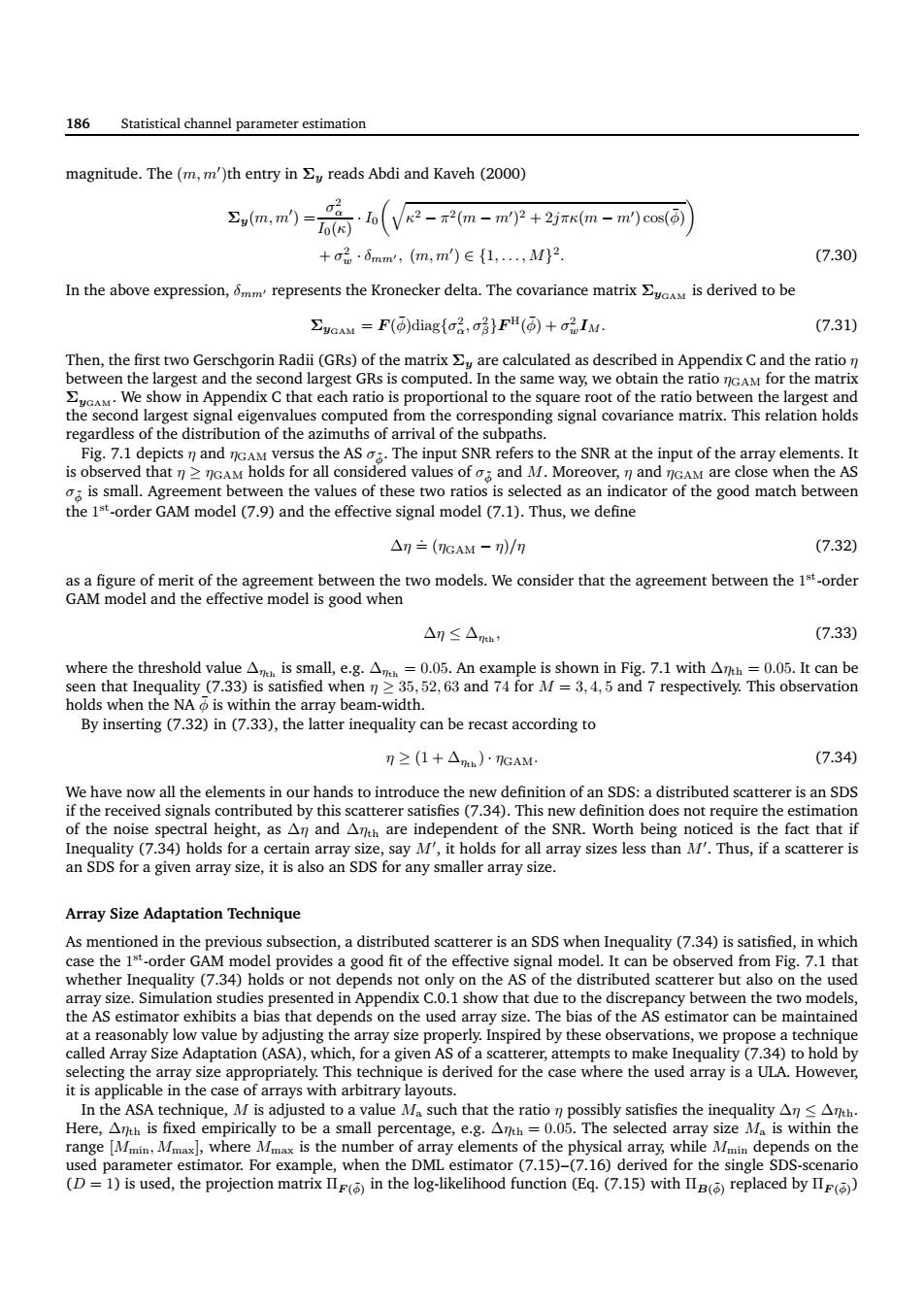正在加载图片...

186 Statistical channel parameter estimation magnitude.The(m,m)th entry in reads Abdi and Kaveh (2000) 之vm)=5·a2-2m-mP+2rm-m☑e0心(高) 8mm,(m.m)e(1.....M2 7.30) In the above expression,represents the Kronecker delta.The covariance matrix is derived to be EyoAM =F()diag(o,(+Ixt. (7.31) Then,the first in radii (Grs)of the m calculated as de ihad in A regardless of the distribution of the azimuths of arrival of the subpaths. array elements. 本业se △=(GAM-)/ (7.32) of the between the two models.We consider that the agreement between the 1order △I≤△p (7.33) where the threshold value△is small..e,g.△ =0.05.An example is shown in Fig.7.1 with An =0.05.It can be tished when n .52.63 and 74 forM=3,4.5 and 7 respectively.This observation 刀2(1+△)GAM (7.34) all tha ands to i definition of SDS:a dis is an SDS w definition does not require the estimation ight,as An andn are SNR.Wor the fact that an SDS for aven arr size.it is als an SDS for any smaller anay size hus,if a scatterer is Array Size Adaptation Technique buted scatterer is an SDS whe en Inequality(7.34)is satisfied,in which epancy between the two models depends on the sed ed byth or can be mch attempts to make Inequality(7 the cae hiere te uind amay h UA tinne 4)to hold by pns popnpe a small percentage,e.g. h od function(Eq.(7.l5)with ()replaced byr(a186 Statistical channel parameter estimation magnitude. The (m, m′ )th entry in Σy reads Abdi and Kaveh (2000) Σy(m, m′ ) = σ 2 α I0(κ) · I0 q κ 2 − π 2(m − m′) 2 + 2jπκ(m − m′) cos(φ¯) + σ 2 w · δmm′ , (m, m′ ) ∈ {1, . . . , M} 2 . (7.30) In the above expression, δmm′ represents the Kronecker delta. The covariance matrix ΣyGAM is derived to be ΣyGAM = F(φ¯)diag{σ 2 α, σ2 β }F H(φ¯) + σ 2 wIM . (7.31) Then, the first two Gerschgorin Radii (GRs) of the matrix Σy are calculated as described in Appendix C and the ratio η between the largest and the second largest GRs is computed. In the same way, we obtain the ratio ηGAM for the matrix ΣyGAM . We show in Appendix C that each ratio is proportional to the square root of the ratio between the largest and the second largest signal eigenvalues computed from the corresponding signal covariance matrix. This relation holds regardless of the distribution of the azimuths of arrival of the subpaths. Fig. 7.1 depicts η and ηGAM versus the AS σφ˜. The input SNR refers to the SNR at the input of the array elements. It is observed that η ≥ ηGAM holds for all considered values of σφ˜ and M. Moreover, η and ηGAM are close when the AS σφ˜ is small. Agreement between the values of these two ratios is selected as an indicator of the good match between the 1 st-order GAM model (7.9) and the effective signal model (7.1). Thus, we define ∆η .= (ηGAM − η)/η (7.32) as a figure of merit of the agreement between the two models. We consider that the agreement between the 1 st-order GAM model and the effective model is good when ∆η ≤ ∆ηth , (7.33) where the threshold value ∆ηth is small, e.g. ∆ηth = 0.05. An example is shown in Fig. 7.1 with ∆ηth = 0.05. It can be seen that Inequality (7.33) is satisfied when η ≥ 35, 52, 63 and 74 for M = 3, 4, 5 and 7 respectively. This observation holds when the NA φ¯ is within the array beam-width. By inserting (7.32) in (7.33), the latter inequality can be recast according to η ≥ (1 + ∆ηth ) · ηGAM. (7.34) We have now all the elements in our hands to introduce the new definition of an SDS: a distributed scatterer is an SDS if the received signals contributed by this scatterer satisfies (7.34). This new definition does not require the estimation of the noise spectral height, as ∆η and ∆ηth are independent of the SNR. Worth being noticed is the fact that if Inequality (7.34) holds for a certain array size, say M′ , it holds for all array sizes less than M′ . Thus, if a scatterer is an SDS for a given array size, it is also an SDS for any smaller array size. Array Size Adaptation Technique As mentioned in the previous subsection, a distributed scatterer is an SDS when Inequality (7.34) is satisfied, in which case the 1 st-order GAM model provides a good fit of the effective signal model. It can be observed from Fig. 7.1 that whether Inequality (7.34) holds or not depends not only on the AS of the distributed scatterer but also on the used array size. Simulation studies presented in Appendix C.0.1 show that due to the discrepancy between the two models, the AS estimator exhibits a bias that depends on the used array size. The bias of the AS estimator can be maintained at a reasonably low value by adjusting the array size properly. Inspired by these observations, we propose a technique called Array Size Adaptation (ASA), which, for a given AS of a scatterer, attempts to make Inequality (7.34) to hold by selecting the array size appropriately. This technique is derived for the case where the used array is a ULA. However, it is applicable in the case of arrays with arbitrary layouts. In the ASA technique, M is adjusted to a value Ma such that the ratio η possibly satisfies the inequality ∆η ≤ ∆ηth. Here, ∆ηth is fixed empirically to be a small percentage, e.g. ∆ηth = 0.05. The selected array size Ma is within the range [Mmin, Mmax], where Mmax is the number of array elements of the physical array, while Mmin depends on the used parameter estimator. For example, when the DML estimator (7.15)–(7.16) derived for the single SDS-scenario (D = 1) is used, the projection matrix ΠF (φ¯) in the log-likelihood function (Eq. (7.15) with ΠB(φ¯) replaced by ΠF (φ¯) )